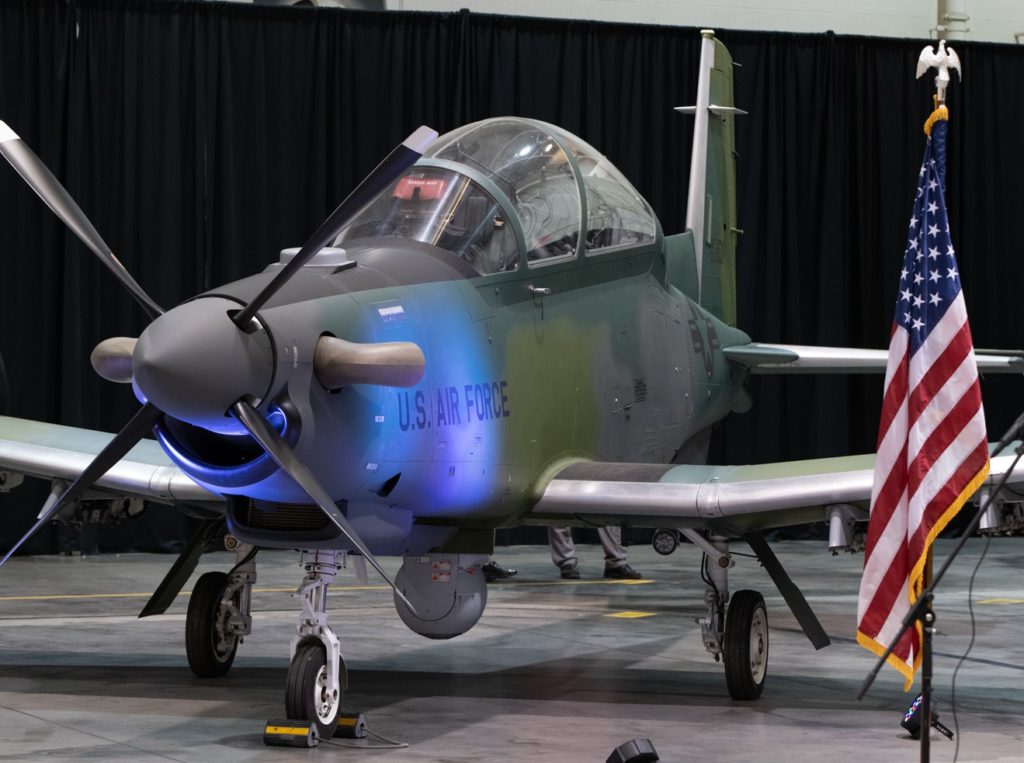Estimated reading time 9 minutes, 15 seconds.
The U.S. Air Force (USAF) has taken delivery of the first of two Beechcraft AT-6E Wolverine light attack aircraft. The news was disclosed in a tweet by the Air Force Life Cycle Management Center on Feb. 17. It said: “A new aircraft just entered the USAF fleet! Congrats to our Fighters and Advanced Aircraft Directorate’s Light Attack Aircraft Program Office, for leading efforts to acquire and field Textron Aviation’s AT-6 Wolverine!”

The USAF Light Attack Office at Wright-Patterson Air Force Base, Dayton, Ohio, and Textron Aviation Defense marked the handover of the first AT-6E during a ceremony in Wichita, Kansas, on Feb. 3, 2021, after the aircraft was formally transferred to the USAF on Dec. 18, 2020. It is the first of two AT-6Es that will support the Continued Light Attack Experiment (CLAE), which is designed to explore cost effective solutions to Countering Violent Extremist Organizations (C-VEO) by co-developing and implementing tactics, techniques, and procedures with partner nations via the use of a light attack aircraft.
In March 2020, the USAF Life Cycle Management Center finalized a $70.2-million Other Transaction Authority (OTA) for two AT-6Es, pilot training, engineering services and up to four years of contractor support for maintenance and spares. The two AT-6Es comprise of one existing aircraft from Textron’s AT-6 demonstration and test fleet, and one new-build aircraft. Upon receipt of the AT-6E military type certification in 2021, Textron Aviation Defense will begin training USAF instructor pilots from the 81st Fighter Squadron at Moody Air Force Base, Georgia, in preparation for the commencement of CLAE, which will run from January-May 2022.
The delivery of the first AT-6E to the USAF comes after more than a decade of studies designed to pave the way for the induction of a new light attack aircraft into its inventory. This dates back to a 2008 requirement for an aircraft with a small logistical footprint that could operate from austere bases to fight in irregular warfare in the shape of an off-the-shelf design to ensure a more rapid development, evaluation, and fielding cycle, at a reduced cost. This led to the issue of a Light Attack/Armed Reconnaissance (LAAR) Capability Request for Information (CRFI) in 2009, which initially envisaged a $2-billion purchase of 100 aircraft.
The field of candidates included the AT-6 from the outset, with Beechcraft offering fleet commonality with its T-6 Texan II trainer that has surpassed 4.1 million flight hours with nearly 1,000 aircraft in service across 12 nations, including two NATO programs as well as the USAF, U.S. Navy, U.S. Marine Corps, U.S. Coast Guard, and U.S. Army. The AT-6 is optimized for the light attack role, while retaining 85 percent parts commonality with the T-6 trainer. However, LAAR fell victim to progressive budget cuts, and the emphasis shifted away from being USAF assets towards building the capabilities of allies, such as the Afghan National Army Air Corps, which purchased 20 Sierra Nevada Corporation/Embraer A-29 Super Tucanos in 2011.
Meanwhile, the U.S. Air National Guard Air Force Reserve Command Test Center began evaluating the AT-6B in a congressionally funded technology demonstration of integrated ISR (intelligence, surveillance and reconnaissance) and weapons system capabilities. Beechcraft built two AT-6 prototypes with company funds, which flew government-funded sorties as part of a $15.4-million demonstration and evaluation program. It enabled Air National Guard and Air Force Reserve Command pilots to gain significant experience of the AT-6.
A series of evaluations saw the AT-6 participate in realistic irregular warfare training sorties, employing a wide range of ordnance including 500-pound and 250-lb laser-guided munitions, use of 0.50-cal gun pods, and employing laser-guided rockets — as Beechcraft continued to develop and demonstrate the Wolverine, incorporating advanced technology including automated self-protection against ground threats and a new data link system.
As part of an initiative to crystallize its strategy, the USAF launched a first Light Attack Experiment at Holloman AFB, New Mexico, in the summer of 2017, which looked at a range of different platforms suitable for the role. A follow-on phase in the summer of 2018 concentrated on the SNC/Embraer A-29B and the Beechcraft AT-6 Wolverine. The USAF subsequently issued a draft solicitation for as many as 350 new Light Attack aircraft in August 2018, and had hoped to release the final request for proposals (RFP) the following December. However, this never materialized.
USAF chief of staff Gen David Goldfein explained a change in overall strategy with regard to Light Attack in July 2019, saying that the air force would in fact buy a small number of AT-6s and A-29s, modify them, and then allow interested nations access to the ongoing work. The USAF released a request for proposals associated with the purchase of two or three examples of the AT-6 in 2019, to be used for building allies and partner capacity; capability and interoperability; and training and experimentation. Part of this work for the AT-6s will be working with AEROnet (Airborne Extensible Relay Over-Horizon Network), a low-cost communications and data-sharing architecture designed to work across allied nations.
Initial plans called for the AT-6s to be based at Nellis AFB, Nevada, however this has now changed for them to join the 81st FS at Moody — a unit that has played a central role in training new A-29 pilots for the likes of Afghanistan and Lebanon. Alongside the AT-6 involvement with CLAE in 2022, Air Force Special Operations Command (AFSOC) has purchased three A-29 Super Tucanos, which are expected to be delivered to Hurlburt Field, Florida, to assist with ongoing studies related to light attack and ISR roles. AFSOC is expected to launch a series of demonstration flights related to its Armed Overwatch project later this year. According to AFSOC commander LGen James Slife, several different aircraft will be evaluated ahead of possible purchase in 2022.